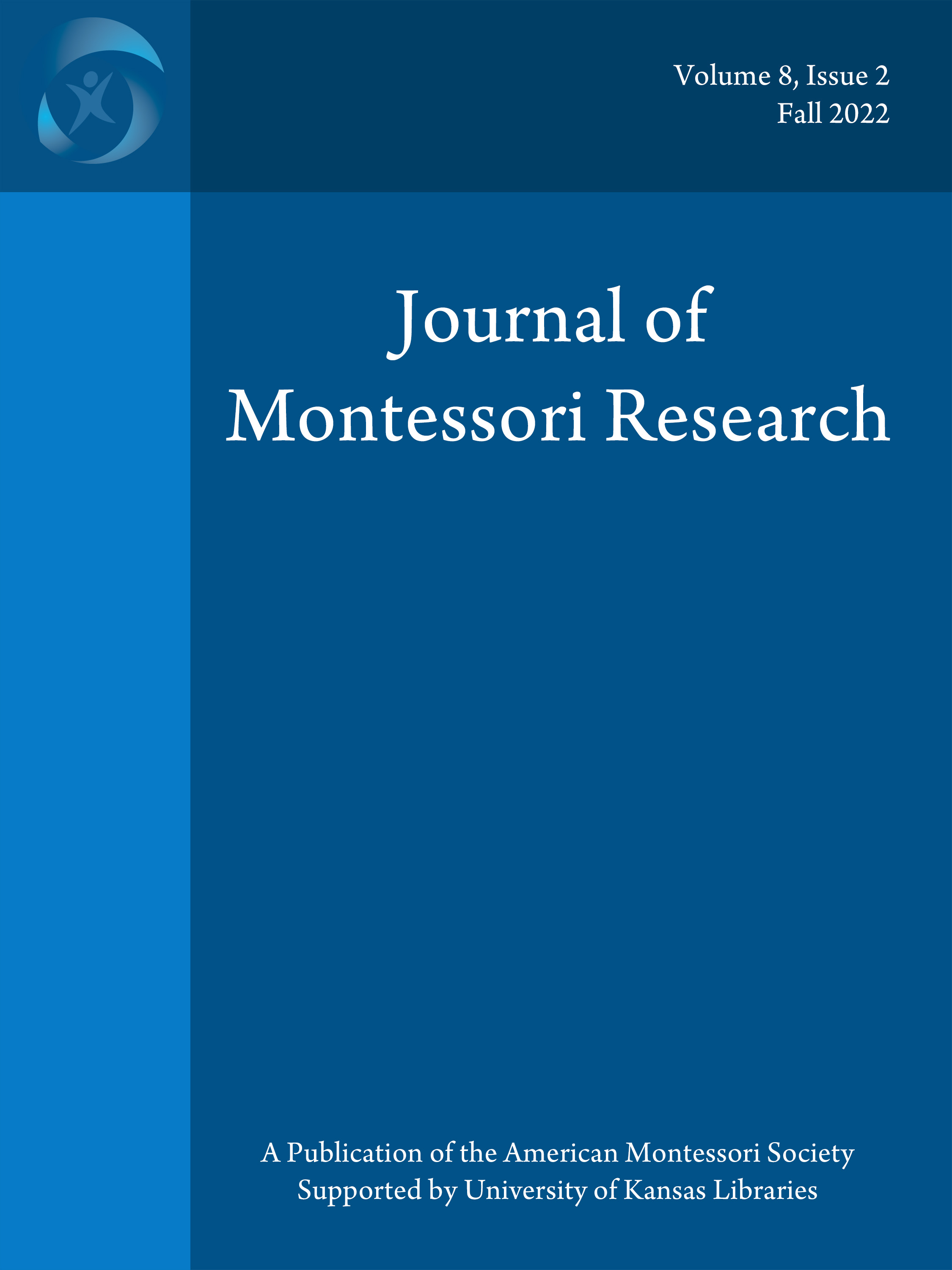The Montessori Method, and the Neurosequential Model in Education (NME)
A Comparative Study
DOI:
https://doi.org/10.17161/jomr.v8i2.18419Keywords:
Montessori Method, The Neurosequential Model in Education (NME), Sensitive periods in development, neuroscience and MontessoriAbstract
The Neurosequential Model in Education (NME) is described as a developmentally sensitive and biologically respectful approach to development and learning. This paper postulates that the NME shares many commonalities with the Montessori Method in that it, too, is developmentally sensitive and adheres to biologically respectful concepts. This paper compares some of the core principles and recommended practices of the NME with those in the Montessori Method and argues that they share many commonalities. The paper also examines Dr. Montessori’s unique use of “sensitive periods” in development for educational purposes, in particular her use of the sensitive periods for movement, the social aspects of life and the sensitive period for order respectively. It argues that in doing this she was actively promoting an approach to human development and education that appears to correlate with what Dr. Bruce Perry calls a developmentally sensitive and biologically respectful approach to learning. The goal of this study is to show the science behind why many of Dr. Montessori’s original practices worked and had such a positive effect on children. This knowledge should empower Montessori educators and give them the confidence to promote authentic Montessori practices in the knowledge that they are in line with current neuroscientific theories that have been shown to be beneficial to children.
References
Babini, V. (2000). Science, feminism, and education: The early work of Maria Montessori.
History Workshop Journal, 49(1), 44–67. https://doi.org/10.1093/hwj/2000.49.44
Babini, V., & Lama, L. (2000). Una donna nuova: Il femminisimo scientifico di Maria Montessori. Milano, Italy: Franco Angeli.
Braun, V., & Clarke, V. (2006). Using thematic analysis in psychology. Qualitative Research in Psychology, 3(2), 77–101. https://doi.org/10.1191/1478088706qp063oa
Braun, V., & Clarke, V. (2022). Thematic analysis: A practical guide. SAGE Publications Ltd.
Craig, S. E. (1992). The Educational Needs of Children Living with Violence. Phi Delta Kappan, 74(1), 67–68, 70–71.
Denervaud, S., Christensen, A., Kenett, Y., & Beaty, R. (2022). How school systems shape children’s knowledge and creative abilities. https://npjscilearncommunity.nature.com
De Stefano, C. (2022). The child is the teacher: A life of Maria Montessori. Other Press.
Fynne, R. J. (1924). Montessori and her Inspirers. Longmans; Green and Co.
Galitch, S. (2021, May 15). Science—Montessori is good for the brain. Archyworldys. https://www.archyworldys.com/science-montessori-is-good-for-the-brain/
George, A. E. (1912, July). Dr. Maria Montessori: The achievement and personality of an Italian woman whose discovery is revolutionizing educational methods. Good Housekeeping, 55(1), 24–29.
Grigsby, J., & Stevens, D. W. (2001). Neurodynamics of Personality. The Guilford Publications.
Horne, H. (1904). The Philosophy of Education. Macmillan Press.
Itard, J. (1802). An Historical Account of the Discovery and Education of a Savage Man. Richard Phillips.
Kramer, R. (1976). Maria Montessori: A biography. Basil Blackwell. Oxford.
Lillard, A., & Else-Quest, N. (2006). Evaluating Montessori Education. Science, 313(5795), 1893–1894. https://doi.org/10.1126/science.1132362
Ludy-Dobson, C. R., & Perry, B. D. (2010). The role of healthy relational interactions in buffering the impact of childhood trauma. In E. Gil (Ed.), Working with children to heal interpersonal trauma: The power of play. The Guilford Press.
Montessori, M. (1909). Il metodo della pedagogia scientifica applicato all’educazione infantile nelle case dei bambini. Scipione Lapi.
Montessori, M. (1913). Pedagogical anthropology (F. T. Cooper, Trans.). Frederick A. Stokes Company.
Montessori, M. (1936). The secret of childhood (B. B. Carter, Ed. And Trans.). Longmans; Green and Co.
Montessori, M. (2013). The House of Children, Lecture, Kodaikanal, 1944. NAMTA Journal, 38(1), 11–19.
Montessori, M. (1964). The Montessori method (A. E. George, Trans.). Schocken Books. (Original work published 1912)
Montessori, M. (1967). The absorbent mind (C. A. Claremont, Trans). Holt, Rinehart and Winston. (Original work published 1949)
Montessori, M. (1971). The Four Planes of Education. AMI Communications.
Montessori, M. (1975). The Formation of Man. (Trans. by A.M. Joosten) Kalakshetra Publications. (Original work published 1949)
Montessori, M. (2008). The California lectures of Maria Montessori, 1915: Collected speeches and writings (R. Buckenmeyer, Ed.). Montessori-Pierson Publishing Company.
Perry, B. D. (2009). Examining child maltreatment through a neurodevelopment lens: Clinical applications of the Neurosequential Model of Therapeutics. Journal of Loss and Trauma, 14(4), 240–255. https://doi.org/10.1080/15325020903004350
Perry, B. D., & Szalavitz, M. (2017). The boy who was raised as a dog: And other stories from a child psychiatrist’s notebook—what traumatized children can teach us about loss, love, and healing. Basic books.
Perry, B. D., & Winfrey, O. (2021). What happened to you? Conversations on trauma, resilience, and healing. Flatiron Books.
Phillips, B., O’Toole, C., McGilloway, S., & Phillips, S. (2022). Montessori, the white cross, and trauma-informed practice: Lessons for contemporary education. Journal of Montessori Research, 8(1), 13–28. https://doi.org/10.17161/jomr.v8i1.15767
Radice, S. (1920). The New Children: Talks with Maria Montessori. Frederick A. Stokes Company.
Séguin, E. (1866). Idiocy and its Treatment by the Physiological Method. William Wood & Co.
Standing, E. M. (1957). Maria Montessori: Her life and work. Plume.
Stevens, E. Y. (1912). The Montessori Method and the American kindergarten. McClure’s Magazine, 40, 77–82. ThinkTVPBS. (2020a, August 25). Stress, trauma, and the brain: Insights for educators—the neurosequential model [video]. YouTube. https://www.youtube.com/watch?v=_3is_3XHKKs&ab_channel=ThinkTVPBS
ThinkTVPBS. (2020b, August 25). Stress, trauma, and the brain: Insights for educators—how stress impacts brain function. YouTube. https://www.youtube.com/watch?v=_3is_3XHKKs&ab_channel=ThinkTVPBS
ThinkTVPBS. (2020c, August 25). Stress, trauma, and the brain: Insights for educators—the power of connection. YouTube. https://www.youtube.com/watch?v=_3is_3XHKKs&ab_channel=ThinkTVPBS
ThinkTVPBS. (2020d, August 25). Stress, trauma, and the brain: Insights for educators—regulating yourself and your classroom. YouTube. https://www.youtube.com/watch?v=_3is_3XHKKs&ab_channel=ThinkTVPBS
ThinkTVPBS. (2020e, August 25). Stress, trauma, and the brain: Insights for educators—educator strategies for the classroom. YouTube. https://www.youtube.com/watch?v=_3is_3XHKKs&ab_channel=ThinkTVPBS
Downloads
Published
Issue
Section
License
Copyright (c) 2022 Bernadette Phillips

This work is licensed under a Creative Commons Attribution-NonCommercial 4.0 International License.


